[press release]
Issue date 13th May 2015
 Stamp design and background
Stamp design and background
Award-winning illustrator and print-maker Chris Wormell was commissioned to create images of the six beasts chosen for this stamp issue. Working closely with Royal Mail and a heraldic expert, he portrayed all of the beasts except the falcon in the ‘passant’ position, that is, facing the viewer’s left and with the right foreleg raised. The brightly coloured background, chosen from a heraldically appropriate palette, adds vibrancy of the images.
Stamp Set with Carrier Card £3.72 Code ZS034
The Heraldic Beasts carrier card, designed by Osborne Ross and written by Jim K Davies, features a brief introduction to the origins of heraldry and a description of each of the six beasts featured on stamps: lion, unicorn, yale, dragon, falcon and griffin. It also describes illustrator Chris Wormell’s method of working and includes sketches he made before tracing them onto lino boards and preparing the final images using traditional tools, hand-printing and Photoshop.
First Day Covers
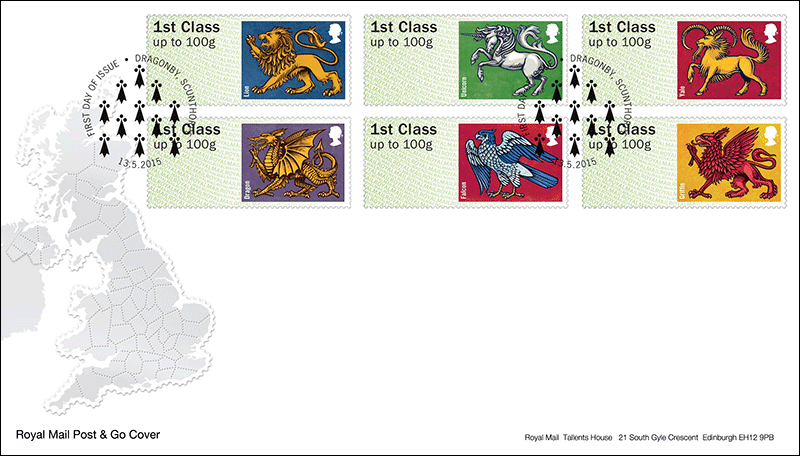 Inland £4.94 Code: ZF018
Inland £4.94 Code: ZF018
Overseas £4.12 Code: ZF018
First Day Envelope 30p Code: ZE017
The filler card includes similar information to that included on the carrier card, except that it features sketches of different beasts.
The alternative handstamp location – Dragonby, Scunthorpe – has been chosen based on its name.
Post & Go Stamps HERALDIC BEASTS Stamp Specifications
Number of stamps: Six
Date of issue: 13 May 2015
Design: Osborne Ross
Acknowledgements: illustrations and sketches by Chris Wormell
Printer: International Security Printers
Process: Gravure
Format: Landscape
Size: 56mm x 25mm
Perforations: Die-cut simulated
Phosphor: Bars as appropriate
Gum: Self-adhesive
Beasts of all persuasions and permutations have appeared on coats of arms and heraldic badges for nearly 900 years. Each has its own particular meaning and significance, but often they include traits demonstrated in battle, such as courage, strength and resilience. One reason for this is that heraldry originally emerged from the need to distinguish participants in combat when their faces were hidden by armour. From these practical beginnings, however, heraldry developed into a complex and sophisticated visual language. Royal Mail’s Post & Go: Heraldic Beasts stamps feature six creatures found in British heraldry as interpreted by Chris Wormell, an English illustrator best known for his distinctive etching and linocut work. The beasts, with the exception of the falcon, are shown ‘passant’ – that is, walking towards the viewer’s left, with the right foreleg raised and the others on the ground. Each painstakingly hand-crafted image occupies a brightly coloured background chosen from a heraldically appropriate palette to add to the vibrancy.
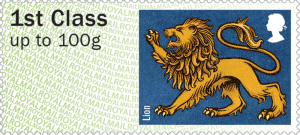 The lion is one of the most familiar ancient heraldic figures, or charges, often representing courage and valour in battle. The king of beasts can also signify Christ or royalty and comes in a bewildering array of poses and variations, from double-headed to crowned, wielding a sword or with a knotted tail.
The lion is one of the most familiar ancient heraldic figures, or charges, often representing courage and valour in battle. The king of beasts can also signify Christ or royalty and comes in a bewildering array of poses and variations, from double-headed to crowned, wielding a sword or with a knotted tail.
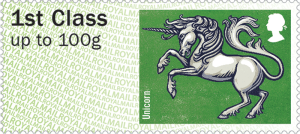 The unicorn has the body of a horse, the tail of a lion and the legs of a deer – as well as an impressive spiral horn protruding from its face. Known for its virtue, courage and strength, the unicorn was a relative latecomer to the heraldic bestiary, first gaining popularity during the 15th century.
The unicorn has the body of a horse, the tail of a lion and the legs of a deer – as well as an impressive spiral horn protruding from its face. Known for its virtue, courage and strength, the unicorn was a relative latecomer to the heraldic bestiary, first gaining popularity during the 15th century.
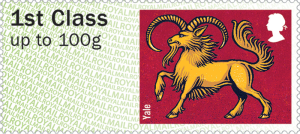 The yale is another mythological hybrid, about the size of a hippopotamus, usually with a goat-like body and the tusks of a boar, although descriptions vary wildly. Most agree on its crowning glory: a pair of large, swivelling horns, perfect for fighting – the reason it came to symbolise ‘proud defence’.
The yale is another mythological hybrid, about the size of a hippopotamus, usually with a goat-like body and the tusks of a boar, although descriptions vary wildly. Most agree on its crowning glory: a pair of large, swivelling horns, perfect for fighting – the reason it came to symbolise ‘proud defence’.
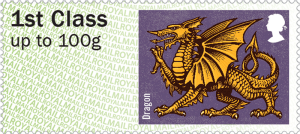 The dragon is a mainstay of heraldry, usually portrayed as a large, ferocious reptilian beast with bat-like wings, a forked tongue and a pointed tail. These fire-spewing creatures are known for their keen sight, power and wisdom – and as zealous guardians of treasure. A two-footed dragon is called a wyvern.
The dragon is a mainstay of heraldry, usually portrayed as a large, ferocious reptilian beast with bat-like wings, a forked tongue and a pointed tail. These fire-spewing creatures are known for their keen sight, power and wisdom – and as zealous guardians of treasure. A two-footed dragon is called a wyvern.
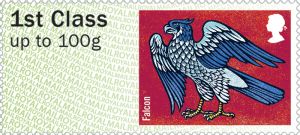 The falcon is one of many birds, actual and imagined, to feature in heraldry. It symbolises majesty and power – as well as someone utterly determined, who does not rest until his or her goal is achieved. Anne Boleyn’s badge bore a crowned falcon with a sceptre, later adopted by her daughter, Queen Elizabeth I.
The falcon is one of many birds, actual and imagined, to feature in heraldry. It symbolises majesty and power – as well as someone utterly determined, who does not rest until his or her goal is achieved. Anne Boleyn’s badge bore a crowned falcon with a sceptre, later adopted by her daughter, Queen Elizabeth I.
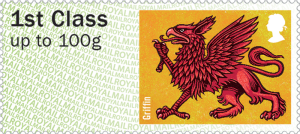 The griffin has the head, wings and talons of an eagle, fused with the back parts of a lion. It is often depicted with large, leonine ears, which reflect its acute sense of hearing, to go along with other extraordinary powers. As a symbol in heraldry, the griffin stands for strength and vigilance.
The griffin has the head, wings and talons of an eagle, fused with the back parts of a lion. It is often depicted with large, leonine ears, which reflect its acute sense of hearing, to go along with other extraordinary powers. As a symbol in heraldry, the griffin stands for strength and vigilance.
ROYAL MAIL POST & GO STAMPS
Post & Go stamps are a new generation of postage available from self-service machines in main Post Offices. The first Post & Go stamps with pictorial designs were introduced in 2010 with a series on British birds. A second series on traditional breeds of farm animals was issued in 2012, followed by a series featuring freshwater life in 2013 and another on British flora in 2014.



